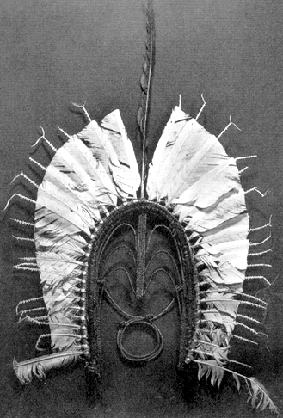A Form of Remembering

At the peak of the long upstanding feather, which was worn by the initiates at the Malo ceremonies, is a white feather tassel signifying the white caps or surf, sign of the strength of the currents beneath. The dancers in the more serious dances wear cone shell pendants, armlets cut from cone shell, cassowary feathers, creations of beauty which are also part of artistic enactment.
In 'dancing out' the movements of their natural environment, they are also acting out the journeys of ancestral figures recorded in myth, ritual and memory. Performance is a form of remembering; of being transported back into the times of ancestral figures. The missionaries 'cut Malo down to pieces', but many of the custodians of Meriam culture today believe that in handing Malo's club from one dancer to the next (as in a Malo dance) the authority of Malo must continue. In this view, with the coming of Christianity the outward form changed, but the inside meaning was handed on. Malo's star-headed clubs have gone, but a laying on of hands is present.
Dari, described by Professor Haddon as the 'finest head-dress' is traditionally a ceremonial head-dress. The dari, depicted on the Torres Strait flag, is made on an open-work or covered frame of bars of split cane fastened together by a wickerwork technique.
Projected from the framework is a fan-shaped arrangement of the white variety of the reef-heron, known as sir among the Meriam. A strand of black cassowary feathers is joined to the frame carrying the white feathers. A long white Torres Strait pigeon feather is fastened in a horizontal position to each side of the base. A single sea-bird feather projects upward in a central position to which a white tassel is attached.
In 'dancing out' the movements of their natural environment, they are also acting out the journeys of ancestral figures recorded in myth, ritual and memory. Performance is a form of remembering; of being transported back into the times of ancestral figures. The missionaries 'cut Malo down to pieces', but many of the custodians of Meriam culture today believe that in handing Malo's club from one dancer to the next (as in a Malo dance) the authority of Malo must continue. In this view, with the coming of Christianity the outward form changed, but the inside meaning was handed on. Malo's star-headed clubs have gone, but a laying on of hands is present.
Dari, described by Professor Haddon as the 'finest head-dress' is traditionally a ceremonial head-dress. The dari, depicted on the Torres Strait flag, is made on an open-work or covered frame of bars of split cane fastened together by a wickerwork technique.
Projected from the framework is a fan-shaped arrangement of the white variety of the reef-heron, known as sir among the Meriam. A strand of black cassowary feathers is joined to the frame carrying the white feathers. A long white Torres Strait pigeon feather is fastened in a horizontal position to each side of the base. A single sea-bird feather projects upward in a central position to which a white tassel is attached.
Keywords: ceremony, dari, Malo dance, Meriam culture, shells
Still: Dhari, head-dress, made of white seabird and cassowary feathers bound to an ochred cane frame.
Author: Sharp, Nonie
© Courtesy of Haddon Collection, Cambridge University Museum of Archaeology and Anthropology.(Catalogue No: Z.7531)
Author: Sharp, Nonie
© Courtesy of Haddon Collection, Cambridge University Museum of Archaeology and Anthropology.(Catalogue No: Z.7531)
